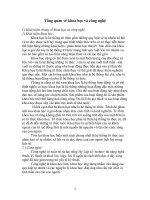Tổng quan vi rút học: Viruses, viroids, and prions
Bạn đang xem bản rút gọn của tài liệu. Xem và tải ngay bản đầy đủ của tài liệu tại đây (4.37 MB, 141 trang )
Viruses, Viroids, and Prions
Bui Thi Viet Ha, Ph.D
Department of Microbiology, HUS
1
Contents
VIRUS
STRUCTURE
AND GROWTH
General
Properties of
Viruses
Nature of the
Virion
The Virus Host
Quantification of
Viruses
VIRAL
REPLICATION
General Features
of Virus
Replication
Viral Attachment
and Penetration
Production of
Viral Nucleic Acid
and Protein
VIRAL
DIVERSITY
SUBVIRAL
ENTITIES
Overview of Bacterial
Viruses
Defective
Viruses
Virulent
Bacteriophages and T4
Viroids
Temperate
Bacteriophages,
Lambda and P1
Prions
Overview of Animal
Viruses
Retroviruses
2
What are Viruses?
Viruses are
genetic
elements that
cannot
replicate
independently
of a living cell,
called the host
cell.
Viruses are
therefore
obligate
intracellular
parasites that
rely on
entering a
suitable living
cell to carry out
their
replication
cycle.
Viruses do
possess their
own genetic
information
and are thus
independent of
the host cell’s
genome.
3
What are Viruses?
• Unlike plasmids, viruses
have an extracellular form,
the virus particle, that:
– enables them to exist outside
the host for long periods
– facilitates transmission from
one host cell to another.
• To multiply, viruses must
enter a cell in which they
can replicate, a process
called infection.
• Viruses infect bacterial
cells on agar results in
cleared zones called
plaques where the cells
have been lysed.
What are Viruses?
• Viruses are the most numerous microorganisms infect all
types of cellular organisms.
– Therefore, they are interesting in their own right.
• However, scientists also study viruses for what they can
tell us about the genetics and biochemistry of cellular
processes and, for many viruses, the development of
disease.
• Furthermore, viruses are also important tools in microbial
genetics and genetic engineering.
Viruses differ from living cells
• In summary, viruses differ from living cells in at
least three ways:
– (1) their simple, acellular organization;
– (2) the presence of either DNA or RNA, but not both, in
almost all virions (human cytomegalovirus has a DNA
genome and four mRNAs);
– (3) their inability to reproduce independent of cells and
carry out cell division as procaryotes and eucaryotes do.
• Although bacteria such as Chlamydia and
Rickettsia are obligately intracellular parasites like
viruses, they do not meet the first two criteria.
Minireview
1. A virus is an obligate
intracellular parasite
that cannot replicate
without a suitable
host cell.
3. The virus genome
may be introduced
into a new host cell by
infection. The virus
redirects the host
metabolism to support
virus replication.
2. A virion is the
extracellular form of a
virus and contains
either an RNA or a
DNA genome inside a
protein shell.
4. Viruses are
classified by their
nucleic acids and type
of host.
Questions?
– How does a virus differ from a plasmid?
– How does a virion differ from a cell?
– What is a bacteriophage?
Viral History
9
Brief history
- Mayer discovered that the disease was contagious
when he found he could transmit it from plant to plant
by spraying sap extracted from diseased leaves onto
healthy plants.
- He searched for a microbe in the infectious sap but
found none. Mayer conduded that the disease was
caused by unusually small bacteria that could not be
seen with the microscope.
- This hypothesis was tested a decade later by Dimitri
Ivanowsky, a Russian who passed sap from infected
tobacco leaves through a filter designed to remove
bacteria.
Brief history
- Ivanowsky clung to the hypothesis that bacteria caused tobacco
mosaic disease. The pathogenic bacteria were so small they could
pass through the filter.
Or perhaps the bacteria made a filterable toxin that caused the
disease.
- 1897 when the Dutch botanist Martitius Beijerinck discovered that
the infectious agent in the filtered sap could reproduce.
- Beijerinck sprayed plants with the filtered sap, and after these
plants developed mosaic disease he used their sap to infect more
plants, continuing this process through a series of infections.
- The pathogen must have been reproducing, for its ability to cause
disease was undiluted after several transfers from plant to plant.
Discovery of Viruses
•Beijerinck (1897) coined the Latin
name “virus” meaning poison
•He studied filtered plant juices &
found they caused healthy plants to
become sick
12
Tobacco Mosaic Virus
•Wendell Stanley (1935)
crystallized sap from sick
tobacco plants
•He discovered viruses
were made of nucleic acid
and protein
13
Smallpox
•Edward Jenner
(1796)
developed a
smallpox
vaccine using
milder cowpox
viruses
•Deadly viruses
are said to be
virulent
•Smallpox has
been eradicated
in the world
today
14
Viral Structure
and Growth
15
General Properties of Viruses
• Although viruses are not cells
– they nonetheless possess a genome encoding the
information they need in order to replicate.
– However, viruses rely on host cells to provide the energy
and materials needed for replicating their genomes and
synthesizing their proteins.
– they cannot replicate unless they have entered a suitable
host cell.
• Viruses can exist in either extracellular or intracellular forms.
– In its extracellular form the virus particle, called the virion,
– is metabolically inert and does not carry out respiration or
biosynthesis.
Characteristics
•
•
•
•
•
Non living structures
Noncellular
Contain a protein coat called the capsid
Have a nucleic acid core containing DNA or RNA
Capable of reproducing only when inside a HOST cell
17
Characteristics
• Some viruses are enclosed in an
protective envelope
• Some viruses may have spikes to
help attach to the host cell
• Most viruses infect only SPECIFIC
host cells
CAPSID
DNA
ENVELOPE
SPIKE
S
18
Characteristics
•Viral capsids (coats) are
made of individual protein
subunits
•Individual subunits are
called capsomeres
CAPSOMERES
19
Characteristics
•Outside of host cells, viruses
are inactive
•Lack ribosomes and enzymes
needed for metabolism
•Use the raw materials and
enzymes of the host cell to be
able to reproduce
EBOLA VIRUS
HIV VIRUS
20
Characteristics
•Some viruses cause disease
•Smallpox, measles,
mononucleosis, influenza,
colds, warts, AIDS, Ebola
•Some viruses may cause some
cancers like leukemia
•Virus-free cells are rare
MEASLES
21
• ‚Viruses belong to biology because they possess genes,
replicate, evolve, and are adapted to particular hosts,
biotic habitats, and ecological niches. However, ...they
are nonliving infectious entities that can be said, at
best, to lead a kind of borrowed life.’
Marc van Regenmortel and Brian Mahy (2004)
• ‘It’s life, Jim, but not as we know it!’
Dr. McCoy speaking to Captain Kirk of the Starship
Enterprise, Star Trek
22
Viewing Viruses
Viruses are smaller than the
smallest cell
Measured in nanometers
Viruses couldn’t be seen until the
electron microscope was invented in
the 20th century
23
Virus Sizes
- Virions come in
many sizes and
shapes.
- Most viruses are
smaller than
prokaryotic cells,
ranging in size from
0.02 to 0.3 µm (20–300
nm).
- A common unit of
measure for viruses is
the nanometer, which
is one-thousandth of a
micrometer.
Virus Sizes
• Smallpox virus, one of the
largest viruses, is about 200
nm in diameter (about the size
of the smallest cells of
Bacteria).
• Poliovirus, one of the smallest
viruses, is only 28 nm in
diameter (about the size of a
ribosome). Consequently,
viruses could not be properly
characterized until the
invention of the electron
microscope, part way through
the 20th century.









